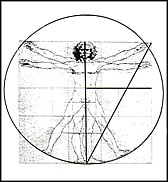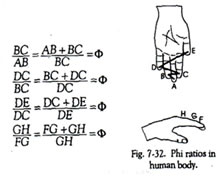



Below is the famous drawing of Leonardo DaVinci called the Vitruvian Man. Amongst other things this drawing shows that the navel sits at the exact Phi ratio between the top of the head and the bottom of the feet. The following extract is from 'The Ancient Secret of the Flower of Life' by Drunvalo Melchizedek.
Da Vinci figured out that if you draw a square around the body, then a diagonal from foot to extended fingertip, then draw a parallel line (another one of those parallel lines) from the navel horizontally over to the side of the square, that horizontal line intercepts the diagonal line exactly at its phi ratio [Fig. 7-31] as well as that of the vertical line from head to feet. Assu ming it's at that perfect point, not slightly above for females or slightly below for males, this means that the human body is divided into phi ratios from top to bottom, which we stated earlier. If these lines were the only places in the human body where the phi ratio is located, it would probably be just an interesting fact. But the truth is, the phi ratio is located in thousands of places throughout the body, and it is not just a coincidence.
If you compare the length of the hand to the length of the lower arm bone, it has a phi ratio, just like the length of the lower arm bone compared to the upper arm bone. . Or take the length of the foot to the lower leg bone, or that bone to the thigh bone and so on. This phi ratio is found throughout the entire bone structure in all kinds of places and ways. It's usually at places where something bends or changes direction. The body also does it through proportionate sizes of one part to another. If you study this, you will be continually amazed The DaVinci Codes The International Best Seller 'The DaVinci Codes is based upon the secret of Phi. The following is an extract from that book. ... 'My friends, as you can see, the chaos of the world has an underlying order. When the ancients discovered PHI, they were certain they had stumbled across God's building block for the world, and they worshipped Nature because of that. And one can understand why. God's hand is evident in Nature, and even to this day there exist pagan, Mother Earth-revering religions. Many of us celebrate Nature the way the pagans did, and don't even know it. May Day is a perfect example, the celebration of spring ... the earth coming back to life to produce her bounty. The mysterious magic inherent in the Divine Proportion was written at the beginning of time. Man is simply playing by Nature's rules, and because art is man's attempt to imitate the beauty of the Creator's hand, you can imagine we might be seeing a lot of instances of the Divine Proportion in art this semester.' Over the next half hour, Langdon showed them slides of artwork by Michelangelo, Albrecht Durer, Da Vinci, and many others, demonstrating each artist's intentional and rigorous adherence to the Divine Proportion in the layout of his compositions. Langdon unveiled PHI in the architectural dimensions of the Greek Parthenon, the pyramids of Egypt , and even the United Nations Building in New York . PHI appeared in the organizational structures of Mozart's sonatas, Beethoven's Fifth Symphony, as well as the works of Bartok, Debussy, and Schubert. The number PHI, Langdon told them, was even used by Stradivarius to calculate the exact placement of the f-holes in the construction of his famous violins.' |
Copyright © Magic Merkabah Angel 2011-12
 When a baby is born, its navel is in the exact geometrical center of the body. Both male and female babies start out this way, and as they grow, the navel starts to move toward the head. It moves up to the phi ratio, then continues upward. Then it comes back down to below the phi ratio, oscillating during the formative years. I don't know what the ages are, but these movements and locations happen at specific ages. It never actually stops at the perfect phi ratio in either males or females, but if I remember correctly, the male navel ends up slightly above the phi ratio and the female navel just below it. If you average the male and female points, you get the perfect phi ratio. So even though Leonardo's drawing is of a male, it assumes that it is at the phi ratio, but of course in nature it would not be.
When a baby is born, its navel is in the exact geometrical center of the body. Both male and female babies start out this way, and as they grow, the navel starts to move toward the head. It moves up to the phi ratio, then continues upward. Then it comes back down to below the phi ratio, oscillating during the formative years. I don't know what the ages are, but these movements and locations happen at specific ages. It never actually stops at the perfect phi ratio in either males or females, but if I remember correctly, the male navel ends up slightly above the phi ratio and the female navel just below it. If you average the male and female points, you get the perfect phi ratio. So even though Leonardo's drawing is of a male, it assumes that it is at the phi ratio, but of course in nature it would not be.  Here are some obvious phi-ratio locations in the human body. The length of each bone in the finger has a phi ratio to the next bone, as shown in the lower drawing. That same ratio occurs with all your fingers and toes. This is a somewhat unusual relationship because one finger longer than the other in what appears to be an arbitrary fashion, but it's not arbitrary - nothing in the human body is. The distances on the fingers marked A to B to C to D to E are all in a phi ratio, as well as the Lengths of the phalanges, F to G to H.
Here are some obvious phi-ratio locations in the human body. The length of each bone in the finger has a phi ratio to the next bone, as shown in the lower drawing. That same ratio occurs with all your fingers and toes. This is a somewhat unusual relationship because one finger longer than the other in what appears to be an arbitrary fashion, but it's not arbitrary - nothing in the human body is. The distances on the fingers marked A to B to C to D to E are all in a phi ratio, as well as the Lengths of the phalanges, F to G to H.